 Technology peripherals
Technology peripherals
 AI
AI
 Using CNN as the basic model, the deformable convolution InternImage achieves a new record in detection and segmentation!
Using CNN as the basic model, the deformable convolution InternImage achieves a new record in detection and segmentation!
Using CNN as the basic model, the deformable convolution InternImage achieves a new record in detection and segmentation!
The booming development of large-scale visual Transformers in recent years has pushed the performance boundaries in the field of computer vision. Vision Transformer models defeat convolutional neural networks by expanding the number of model parameters and training data. Researchers from Shanghai Artificial Intelligence Laboratory, Tsinghua University, Nanda, SenseTime, and Hong Kong Chinese summarized the gaps between convolutional neural networks and visual Transformers. From an operator level, traditional CNNs operators lack long-distance dependencies and adaptive spatial aggregation capabilities; from a structural level, traditional CNNs structures lack advanced components.
In response to the above technical problems, Researchers from Pujiang Laboratory, Tsinghua University and other institutions innovatively proposed a large-scale model based on convolutional neural networks, called For InternImage, it uses sparse dynamic convolution as the core operator and achieves adaptive spatial aggregation by inputting relevant information as a condition. InternImage enables learning more powerful and robust large-scale parameter patterns from massive data by reducing the strict inductive bias of traditional CNNs. Its effectiveness has been verified on visual tasks including image classification, object detection and semantic segmentation. It has achieved competitive results in challenging benchmark data sets including ImageNet, COCO and ADE20K. At the same parameter level, it has surpassed the visual Transformer structure and provided a new direction for large image models.

- ## Paper link: https://arxiv.org/abs/2211.05778
- Open source code: https://github.com/OpenGVLab/InternImage
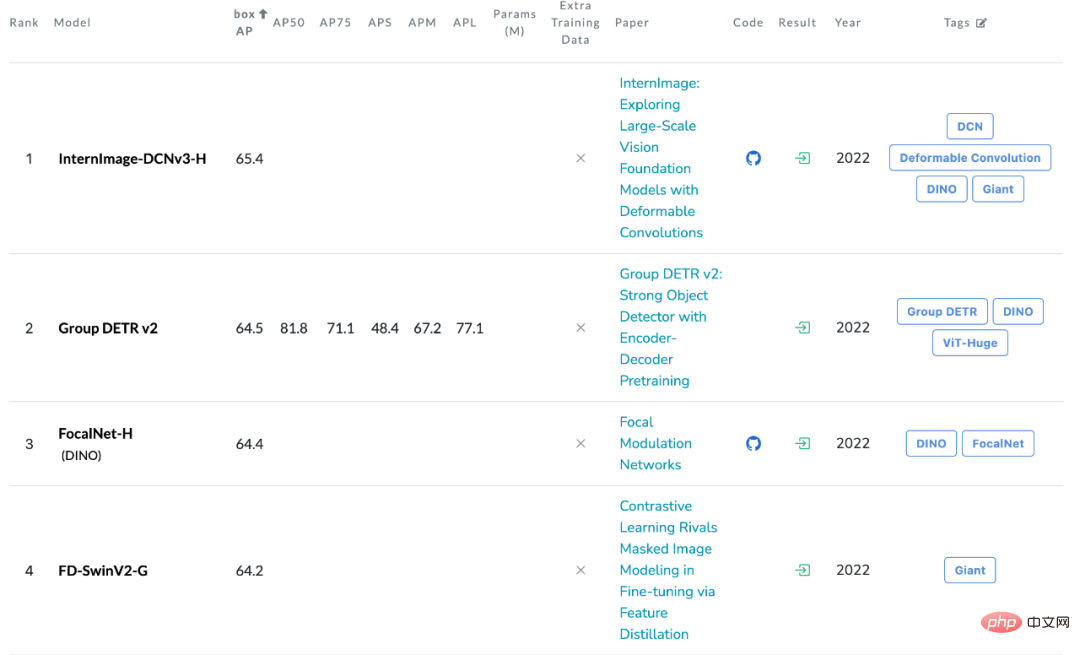
 ##Limitations of traditional convolutional neural networks
##Limitations of traditional convolutional neural networks
(1) From the operator level, the multi-head attention mechanism of visual Transformer has long-distance dependencies And adaptive spatial aggregation capabilities, benefiting from this, the visual Transformer can learn from massive data more powerful and robust representations than CNN networks.
(2) From the perspective of model architecture, in addition to the multi-head attention mechanism, the visual Transformer has more advanced modules that the CNN network does not have, such as Layer Normalization (LN), feedforward Neural network FFN, GELU, etc.
Although some recent work attempts to use large kernel convolutions to obtain long-distance dependencies, they are still far from the state-of-the-art visual Transformers in terms of model scale and accuracy.
Further expansion of deformable convolutional networks
InternImage improves the scalability of convolutional models and alleviates inductive bias by redesigning operators and model structures , including (1) DCNv3 operator, which introduces shared projection weights, multi-group mechanisms and sampling point modulation based on the DCNv2 operator. (2) Basic module, integrating advanced modules as the basic module unit for model construction (3) Module stacking rules, standardizing the width, depth, number of groups and other hyper-parameters of the model when expanding the model.This work is dedicated to building a CNN model that can effectively scale to large-scale parameters. First, the deformable convolution operator DCNv2 is redesigned to adapt to long-distance dependencies and weaken inductive bias; then, the adjusted convolution operator is combined with advanced components to establish a basic unit module; finally, explore and implement Stacking and scaling rules of modules to build a base model with large-scale parameters and powerful representations can be learned from massive data.
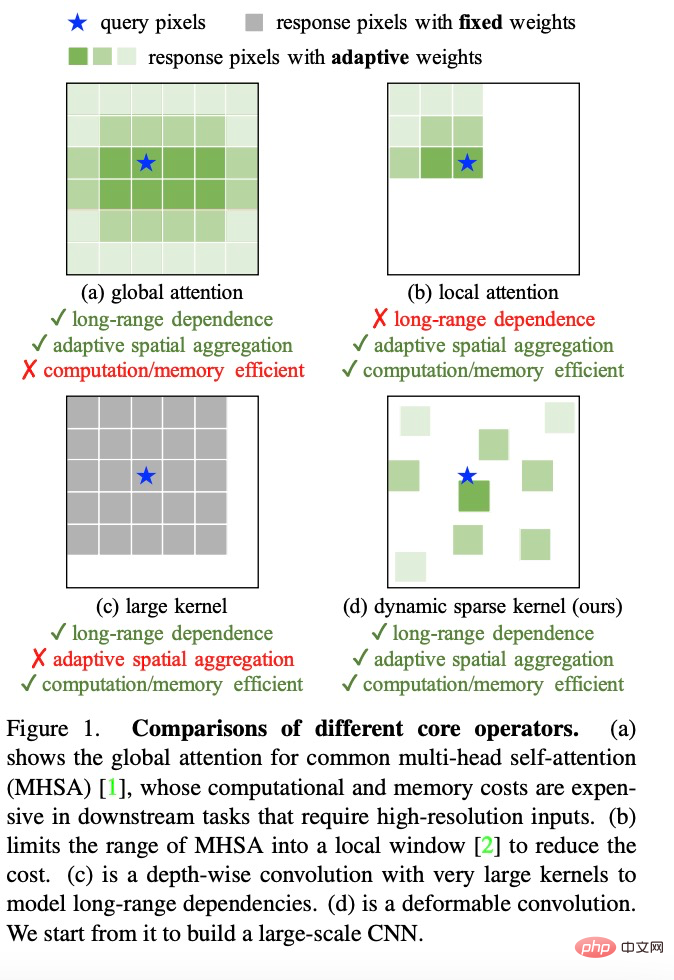
At the operator level, this study first summarizes the main differences between the convolution operator and other mainstream operators. The current mainstream Transformer series models mainly rely on the multi-head self-attention mechanism to achieve large model construction. Its operators have long-distance dependencies, which are sufficient to construct connection relationships between long-distance features, and also have spatial adaptive aggregation capabilities to achieve pixel-level construction. Relationship. However, this global attention mechanism has huge computing and storage requirements, making it difficult to achieve efficient training and rapid convergence. Likewise, local attention mechanisms lack long-range feature dependence. Large-core dense convolution has no spatial aggregation ability, so it is difficult to overcome the natural inductive bias of convolution, which is not conducive to expanding the model. Therefore, InternImage designs dynamic sparse convolution operators to achieve global attention effects without wasting too much computing and storage resources, achieving efficient training.
Based on the DCNv2 operator, the researchers redesigned, adjusted and proposed the DCNv3 operator. Specific improvements include the following parts.
(1) Shared projection weight. Similar to conventional convolution, different sampling points in DCNv2 have independent projection weights, so its parameter size is linearly related to the total number of sampling points. In order to reduce parameter and memory complexity, we draw on the idea of separable convolution and use position-independent weights to replace the grouping weights. The projection weights are shared between different sampling points, and all sampling position dependencies are retained.
(2) Introduce multi-group mechanism. Multi-group design was first introduced in grouped convolution and is widely used in Transformer's multi-head self-attention. It can be paired with adaptive spatial aggregation to effectively improve the diversity of features. Inspired by this, researchers divide the spatial aggregation process into several groups, and each group has an independent sampling offset. Since then, different groups of a single DCNv3 layer have different spatial aggregation patterns, resulting in rich feature diversity.
(3) Sampling point modulation scalar normalization. In order to alleviate the instability problem when the model capacity is expanded, the researchers set the normalization mode to Softmax normalization on a sample-by-sample basis. This not only makes the training process of large-scale models more stable, but also constructs a model of all sampling points. connection relationship.

After building the DCNv3 operator, you first need to standardize the overall details of the basic modules and other layers of the model, and then explore the Stacking strategy to build InternImage. Finally, models with different parameter amounts are constructed according to the expansion rules of the proposed model.
Basic module. Different from the bottleneck structure widely used in traditional CNN, this study adopts a basic module closer to ViTs, equipped with more advanced components, including GELU, layer normalization (LN) and feed-forward network (FFN), which have been Proven to be more efficient in a variety of vision tasks. The details of the basic module are shown in the figure above, where the core operator is DCNv3, which predicts the sampling bias and modulation scale by passing the input features through a lightweight separable convolution. For other components, follow the same design as a normal Transformer.
Overlay rules. In order to clarify the block stacking process, this study proposes two module stacking rules. The first rule is the number of channels in the last three stages , which is determined by the number of channels in the first stage
, which is determined by the number of channels in the first stage Decision, that is,
Decision, that is,  ; The second rule is that the group number of each module corresponds to the number of channels in each stage, that is,
; The second rule is that the group number of each module corresponds to the number of channels in each stage, that is,  ; The third, stacking The mode is fixed to "AABA", that is, the number of module stacks in stages 1, 2 and 4 is the same
; The third, stacking The mode is fixed to "AABA", that is, the number of module stacks in stages 1, 2 and 4 is the same  , and not greater than that in stage 3
, and not greater than that in stage 3  . Therefore, a model with a parameter volume of 30M is chosen as the basis. The specific parameters are: the number of Steam output channels
. Therefore, a model with a parameter volume of 30M is chosen as the basis. The specific parameters are: the number of Steam output channels is 64; the number of groups is 1/16 of the number of input channels in each stage. The number of module stacks
is 64; the number of groups is 1/16 of the number of input channels in each stage. The number of module stacks  in stages 1, 2, and 4 is 4, the number of module stacks
in stages 1, 2, and 4 is 4, the number of module stacks  in stage 3 is 18, and the model parameters are 30M.
in stage 3 is 18, and the model parameters are 30M.
Model scaling rules. Based on the optimal model under the above constraints, this study normalized two scaling dimensions of the network model: depth D (number of module stacks) and width C (number of channels), using the restriction factor  and
and  scale the depth and width along the composite coefficient
scale the depth and width along the composite coefficient  , i.e.,
, i.e.,  , where
, where  , according to experiments the optimal setting is
, according to experiments the optimal setting is  .
.
Following this rule, this study constructed models of different scales, namely InternImage-T, S, B, L, and XL. The specific parameters are:
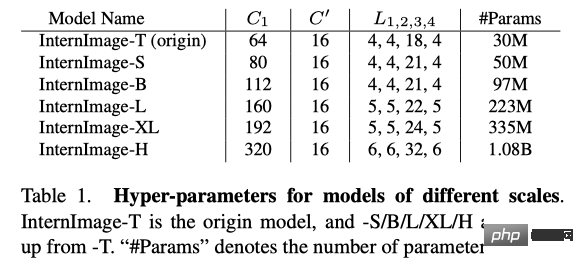
Experimental results
Image classification experiment: By using 427M public data sets: Laion-400M, YFCC15M, CC12M, InternImage-H achieves an accuracy of 89.2% on ImageNet-1K.

Object detection: Taking the largest InternImage-H as Backbone network, and using DINO as the basic detection framework, pre-trained the DINO detector on the Objects365 data set, and then fine-tuned on COCO. The model achieved an optimal result of 65.4% in the target detection task, breaking through the performance boundary of COCO target detection.
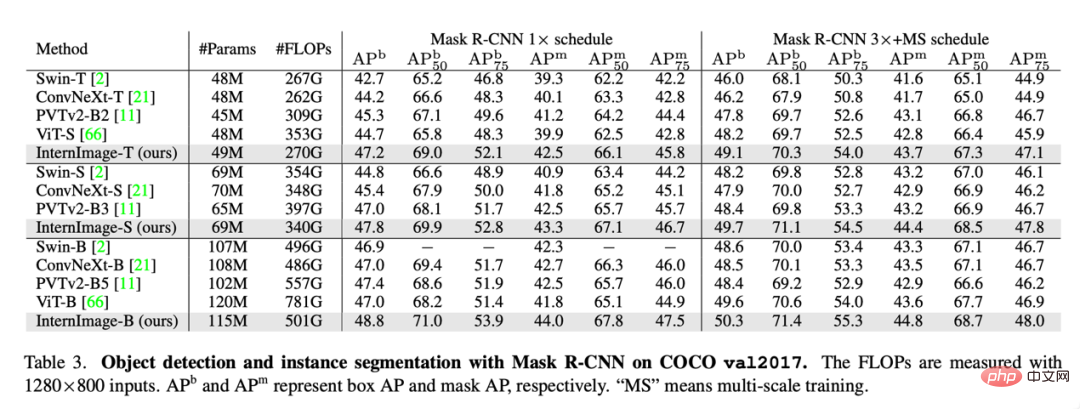
Semantic Segmentation: On semantic segmentation, InternImage-H It also achieved very good performance, and combined with Mask2Former achieved the current highest of 62.9% on ADE20K.
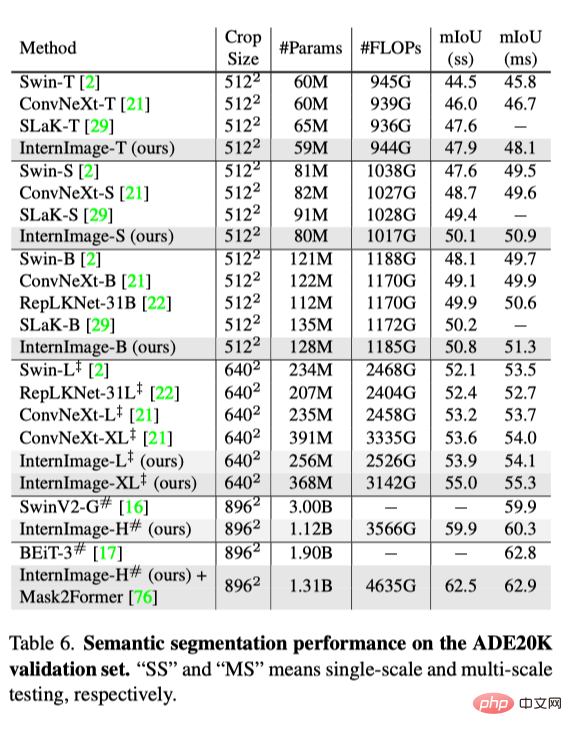
Conclusion
This study proposes InternImage, a new CNN-based large-scale basic model that can Powerful representations are provided for versatile vision tasks such as image classification, object detection, and semantic segmentation. The researchers adjusted the flexible DCNv2 operator to meet the needs of the basic model, and developed a series of blocking, stacking and scaling rules based on the core operator. Extensive experiments on object detection and semantic segmentation benchmarks have verified that InternImage can achieve equivalent or better performance than well-designed large-scale visual Transformers trained on large amounts of data, indicating that CNN is also a considerable step in large-scale visual basic model research. choose. Still, large-scale CNNs are still in their early stages of development, and the researchers hope InternImage can serve as a good starting point.
The above is the detailed content of Using CNN as the basic model, the deformable convolution InternImage achieves a new record in detection and segmentation!. For more information, please follow other related articles on the PHP Chinese website!

Hot AI Tools

Undresser.AI Undress
AI-powered app for creating realistic nude photos

AI Clothes Remover
Online AI tool for removing clothes from photos.

Undress AI Tool
Undress images for free

Clothoff.io
AI clothes remover

Video Face Swap
Swap faces in any video effortlessly with our completely free AI face swap tool!

Hot Article

Hot Tools

Notepad++7.3.1
Easy-to-use and free code editor

SublimeText3 Chinese version
Chinese version, very easy to use

Zend Studio 13.0.1
Powerful PHP integrated development environment

Dreamweaver CS6
Visual web development tools

SublimeText3 Mac version
God-level code editing software (SublimeText3)

Hot Topics
 1392
1392
 52
52
 36
36
 110
110
 The world's most powerful open source MoE model is here, with Chinese capabilities comparable to GPT-4, and the price is only nearly one percent of GPT-4-Turbo
May 07, 2024 pm 04:13 PM
The world's most powerful open source MoE model is here, with Chinese capabilities comparable to GPT-4, and the price is only nearly one percent of GPT-4-Turbo
May 07, 2024 pm 04:13 PM
Imagine an artificial intelligence model that not only has the ability to surpass traditional computing, but also achieves more efficient performance at a lower cost. This is not science fiction, DeepSeek-V2[1], the world’s most powerful open source MoE model is here. DeepSeek-V2 is a powerful mixture of experts (MoE) language model with the characteristics of economical training and efficient inference. It consists of 236B parameters, 21B of which are used to activate each marker. Compared with DeepSeek67B, DeepSeek-V2 has stronger performance, while saving 42.5% of training costs, reducing KV cache by 93.3%, and increasing the maximum generation throughput to 5.76 times. DeepSeek is a company exploring general artificial intelligence
 AI subverts mathematical research! Fields Medal winner and Chinese-American mathematician led 11 top-ranked papers | Liked by Terence Tao
Apr 09, 2024 am 11:52 AM
AI subverts mathematical research! Fields Medal winner and Chinese-American mathematician led 11 top-ranked papers | Liked by Terence Tao
Apr 09, 2024 am 11:52 AM
AI is indeed changing mathematics. Recently, Tao Zhexuan, who has been paying close attention to this issue, forwarded the latest issue of "Bulletin of the American Mathematical Society" (Bulletin of the American Mathematical Society). Focusing on the topic "Will machines change mathematics?", many mathematicians expressed their opinions. The whole process was full of sparks, hardcore and exciting. The author has a strong lineup, including Fields Medal winner Akshay Venkatesh, Chinese mathematician Zheng Lejun, NYU computer scientist Ernest Davis and many other well-known scholars in the industry. The world of AI has changed dramatically. You know, many of these articles were submitted a year ago.
 Google is ecstatic: JAX performance surpasses Pytorch and TensorFlow! It may become the fastest choice for GPU inference training
Apr 01, 2024 pm 07:46 PM
Google is ecstatic: JAX performance surpasses Pytorch and TensorFlow! It may become the fastest choice for GPU inference training
Apr 01, 2024 pm 07:46 PM
The performance of JAX, promoted by Google, has surpassed that of Pytorch and TensorFlow in recent benchmark tests, ranking first in 7 indicators. And the test was not done on the TPU with the best JAX performance. Although among developers, Pytorch is still more popular than Tensorflow. But in the future, perhaps more large models will be trained and run based on the JAX platform. Models Recently, the Keras team benchmarked three backends (TensorFlow, JAX, PyTorch) with the native PyTorch implementation and Keras2 with TensorFlow. First, they select a set of mainstream
 Hello, electric Atlas! Boston Dynamics robot comes back to life, 180-degree weird moves scare Musk
Apr 18, 2024 pm 07:58 PM
Hello, electric Atlas! Boston Dynamics robot comes back to life, 180-degree weird moves scare Musk
Apr 18, 2024 pm 07:58 PM
Boston Dynamics Atlas officially enters the era of electric robots! Yesterday, the hydraulic Atlas just "tearfully" withdrew from the stage of history. Today, Boston Dynamics announced that the electric Atlas is on the job. It seems that in the field of commercial humanoid robots, Boston Dynamics is determined to compete with Tesla. After the new video was released, it had already been viewed by more than one million people in just ten hours. The old people leave and new roles appear. This is a historical necessity. There is no doubt that this year is the explosive year of humanoid robots. Netizens commented: The advancement of robots has made this year's opening ceremony look like a human, and the degree of freedom is far greater than that of humans. But is this really not a horror movie? At the beginning of the video, Atlas is lying calmly on the ground, seemingly on his back. What follows is jaw-dropping
 KAN, which replaces MLP, has been extended to convolution by open source projects
Jun 01, 2024 pm 10:03 PM
KAN, which replaces MLP, has been extended to convolution by open source projects
Jun 01, 2024 pm 10:03 PM
Earlier this month, researchers from MIT and other institutions proposed a very promising alternative to MLP - KAN. KAN outperforms MLP in terms of accuracy and interpretability. And it can outperform MLP running with a larger number of parameters with a very small number of parameters. For example, the authors stated that they used KAN to reproduce DeepMind's results with a smaller network and a higher degree of automation. Specifically, DeepMind's MLP has about 300,000 parameters, while KAN only has about 200 parameters. KAN has a strong mathematical foundation like MLP. MLP is based on the universal approximation theorem, while KAN is based on the Kolmogorov-Arnold representation theorem. As shown in the figure below, KAN has
 FisheyeDetNet: the first target detection algorithm based on fisheye camera
Apr 26, 2024 am 11:37 AM
FisheyeDetNet: the first target detection algorithm based on fisheye camera
Apr 26, 2024 am 11:37 AM
Target detection is a relatively mature problem in autonomous driving systems, among which pedestrian detection is one of the earliest algorithms to be deployed. Very comprehensive research has been carried out in most papers. However, distance perception using fisheye cameras for surround view is relatively less studied. Due to large radial distortion, standard bounding box representation is difficult to implement in fisheye cameras. To alleviate the above description, we explore extended bounding box, ellipse, and general polygon designs into polar/angular representations and define an instance segmentation mIOU metric to analyze these representations. The proposed model fisheyeDetNet with polygonal shape outperforms other models and simultaneously achieves 49.5% mAP on the Valeo fisheye camera dataset for autonomous driving
 Tesla robots work in factories, Musk: The degree of freedom of hands will reach 22 this year!
May 06, 2024 pm 04:13 PM
Tesla robots work in factories, Musk: The degree of freedom of hands will reach 22 this year!
May 06, 2024 pm 04:13 PM
The latest video of Tesla's robot Optimus is released, and it can already work in the factory. At normal speed, it sorts batteries (Tesla's 4680 batteries) like this: The official also released what it looks like at 20x speed - on a small "workstation", picking and picking and picking: This time it is released One of the highlights of the video is that Optimus completes this work in the factory, completely autonomously, without human intervention throughout the process. And from the perspective of Optimus, it can also pick up and place the crooked battery, focusing on automatic error correction: Regarding Optimus's hand, NVIDIA scientist Jim Fan gave a high evaluation: Optimus's hand is the world's five-fingered robot. One of the most dexterous. Its hands are not only tactile
 DualBEV: significantly surpassing BEVFormer and BEVDet4D, open the book!
Mar 21, 2024 pm 05:21 PM
DualBEV: significantly surpassing BEVFormer and BEVDet4D, open the book!
Mar 21, 2024 pm 05:21 PM
This paper explores the problem of accurately detecting objects from different viewing angles (such as perspective and bird's-eye view) in autonomous driving, especially how to effectively transform features from perspective (PV) to bird's-eye view (BEV) space. Transformation is implemented via the Visual Transformation (VT) module. Existing methods are broadly divided into two strategies: 2D to 3D and 3D to 2D conversion. 2D-to-3D methods improve dense 2D features by predicting depth probabilities, but the inherent uncertainty of depth predictions, especially in distant regions, may introduce inaccuracies. While 3D to 2D methods usually use 3D queries to sample 2D features and learn the attention weights of the correspondence between 3D and 2D features through a Transformer, which increases the computational and deployment time.



